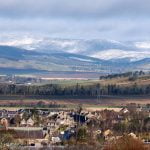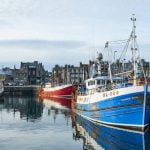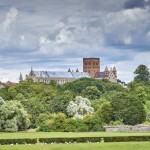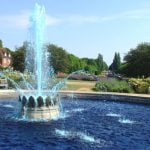Brechin The unofficial capital city of Angus.
Brechin has had city status for years now. Situated in the heart of Angus, this large town is not officially recognised as a city by modern standards, even though it has a former seat of the Reformation Roman Catholic diocese, i.e. a cathedral.
Home to Kinnaird Castle and closer to Dundee than the official capital of Angus, Aberdeen makes it a great base to explore the region and from a tourist point of view the town its self offers plenty of reasons to visit. Anyway, let’s examine the history of the area then move on to the attractions. We’ll even through in some famous people and look up some trivia for Brechin.
Early Days of Brechin
Brechin is home to several different clans. There is the Brechin family themselves, who occupy Brechin Castle in Angus. The clan built the castle in the 18th century when the clans of Maule and Ramsay united under one banner. The castle housed the clan chiefs.
Clan Maule Alexander dates to Alexander Maule, the Earl of Panmure, in 1498. We can trace his clan all the way down to 1619, but the last of the clan proper merged with the Ramsay’s. We know that before the 1400s, Clan Maule came from France. We can assume that they piggy-backed on the Norman Invasion. There were several clans that came here and settled about the same time. The Clan Crawford spring to mind. The clans would usually land and take the name of the area, such as ‘Livingston,’ or ‘Hamilton.’ The Maule clan didn’t, though they did name their first chieftain as ‘Alexander’, a traditional Scottish surname.
Although made unpopular by Game of Thrones, the Clan Ramsay were not a notorious clan in Scotland. There were 5 major strands of Clan Ramsay as early as the 13th century. There are Ramsay’s in Bamff, Dalhousie and Balmain. Other septs of Ramsay are Maule, Brechin, Brecheen, and Rumsey. They have multiple tartans and strands, but it was the Dalhousie strand who settled the area around Brechin and therefore formed clan Brechin itself, years later. Clan Ramsay were fighters, always erring on the side of Scottish royalty and independence. They were first recorded in Scotland in the 1100s when a man named Simon De Ramsay travelled north with the Earl of Huntingdon. The Ramsay’s were The Bruce’s right-hand side through his campaigns.
The Ramsay’s/Brechins/Maules have a historic beef with the Clan Douglas. Every single Scottish clan has beef with one of the others. We love a good feud. The Douglas clan are another lowland clan, a branch of whom was once referred to as the ‘Black Douglases.’ The Clan Douglas once imprisoned one of the Ramsay’s after he found favour with the king. They let him starve to death in a tower.
The Battle of Brechin took place between those loyal to James II and those noble families who joined the Black Douglases to try to overthrow the king. They finally succumbed in 1455 at the Battle of Arkinholm. However, at Brechin, their ally Alexander Lindsay, an earl of Crawford, ended up captured. Clans Ogilvy and Gordon were the victors of that fight.
Scotland in the Middle Ages
David I had Brechin Cathedral built in 1153. Bishop Samson was the first bishop to take charge there. It has since become an episcopalian church, therefore stopping the ‘city’ from being an official ‘city.’ The cathedral that stands today endured extensive 19th-century restorations. The church built the oldest parts of the current cathedral in the 1300s. There is a round tower beside the church. The locals built this in the 10th century in the styles of the round towers of Ireland. Nobody has an explanation for that.
Lord William de Brechin formed the chapel of Maison Dieu Hospital in 1267. This hospital included an almshouse. The French and Scots shared the Auld Alliance back then. This agreement meant that Scotland and France hated England with equal measure. There was already free movement between Scotland and France before the Norman Invasion. We would go so far as to say that Scotland likely helped William the Conqueror take charge. You can trace many of the clans, lands, and titles, of Scotland, back to this time when the French would come and go. To this day, there remains camaraderie and understanding between the two countries that other countries don’t share. The French and the Scots share many liberal views.
In 1303, an earlier version of Brechin Castle suffered a siege by the English king Edward I. Thomas Maule, leader of the army, was killed. It is worth mentioning that Edward I had been to Brechin before[i]. In 1296, John Baliol gave the lordship of Scotland to the king, via the Bishop of Durham. We wonder what the King of England thought of the Grampian mountains and the gorgeous Strathmore landscape. The Earls of Dalhousie lived in Brechin Castle for hundreds of years before the modern building existed. The current Earls of Dalhousie are descendants of Thomas Maule, who died defending the castle from the English in 1303.
That famous battle took place in 1452 and they captured the Earl of Crawford. In 1480, locals constructed a tollbooth, where the current townhouse. The townhouse replaced the tolbooth in 1789. The tolbooths took taxes on trade that came and went from the town. There are tolbooths dotted all over Scotland.
An outbreak of plague took place in Brechin in 1547, although we don’t know how many people died. If you visit the old graveyards in town, you will see many headstones from this time. A Campbell was made Bishop of Brechin in 1557. We all know how hated Clan Campbell was. We can only imagine that being a man of the cloth indemnified Donald Campbell from the hatred inherent to his people. By 1565 the church replaced him with John Sinclair, a far less troublesome choice.
We are about to reach the 1600s, so let’s take a break from the history and see what fun facts we can dig up about Brechin.
Fun Trivia About Brechin, in Angus
We love to dish the dirt on any given tour destination, and Brechin is no exception. Here’s all the gossip we could find about this northern town:
- Brechin is the only city in Angus, although there are those who contest its city status.
- The round tower built in the Irish style in the 10th century (ish) is one of only two surviving towers in Scotland.
- There is a Pictish cottage here which proves the Picts were here at some point.
- Brechin used to be a royal burgh but is not any longer.
- Although the current castle went up in the 1700s, the earlier building was there from the 1300s.
- Brechin is about 9 miles west of Montrose, which was a busy harbour town in the Middle Ages. The town had plenty of fresh fish between the sea and the River Esk.
That’s enough fun for one day. Let’s get back to the clan histories, everyone is always being dramatic and killing each other…
Industrial Era Brechin
Brechin received its Royal Burgh status in 1641, as granted by King Charles I. The evil Earl of Montrose, who often worked with the English to torment the local populace, sacked Brechin in 1645. He destroyed approximately 60 houses, although they might have inflated those reports a little. They did considerable damage to the town, though. Three short years later this damage to the town then grew with an outbreak of plague. History books record that two-thirds of the population died. The 1600s plagues were the same that struck England, they just took longer to travel north. The Brechin Diocese unified with the Edinburgh Diocese from 1695 until 1709. Bishop Alexander Rose of Edinburgh ran the cathedral at Brechin during that time. In 1709 the bishop was John Falconar. The townhouse replaced the tolbooth in 1789.
The locals rebuilt the cathedral in 1806 after years of use had seen it damaged. In 1809, a second church appeared: St Andrew’s Episcopal. In 1838, the Mechanics Institute opened and in 1841 the population was 3,951 people. If there had been no sacking and no plague, it would have been far higher.
The town received its first newspaper, the Brechin Advertiser, in 1848. The Den Burn Works opened in 1864. The works were Brechin’s first industrial era building. It was a factory that produced linens. The workers wove the linen fabric on looms powered by the burns. The Dens Burn powered many mills here during the industrial period. It was a large triangular building, according to eyewitnesses. By 1870 there were four major mills in town. These four mills employed 1,400 people.
The townsfolk gained their first public park in 1867. Public parks were popularised by the Victorians. The towns north of the border have fewer parks because there is more countryside. The town’s population was a little over 5,000 people by 1871, but they didn’t get a piped water supply until three years later. As you can imagine, this meant disease was rife in town.
The first public library opened in Brechin in 1893 after townsfolk took two years to build it. The town commemorates 1892 as well. This is the year the man who invented radar: Sir Robert Alexander Watson-Watt, was born in Brechin.
The railway did not reach Angus and Brechin until 1895. The station opened to support the Caledonian Railway, connecting the town with Dundee. To put this into perspective, towns around London and Essex received the railway in the 1840s. The farther you were from London, the longer it took to reach you. The Scottish Highlands didn’t receive railway lines until as late as the 1900s.
Another church opened in 1897, the Gardner Memorial Church. In 1898, the town received a golf club of its own. Nowadays, there are many clubs in the area to choose from. In fact, the Angus coastline is part of what makes golfing in Scotland so attractive.
Modern Era Brechin
Workers finally fully restored Brechin cathedral to something akin to its original beauty in 1902. To this day, the church is still unhappy at what it went through to get there. The local team started playing in 1906. Brechin City Football Club is still going strong to this day. We love the placement of the word ‘city’ in the title, too. Brechin is a city. Don’t let any silly rules tell you otherwise. The team entered the Scottish Football League in 1923.
We never like to skip out on any town’s contribution to the war efforts. Scottish regiments fought in all the major wars as far back as the Napoleonic and beyond. The local regiment of Brechin and Angus is the Black Watch. You will have heard of the Black Watch. 115 men in the Black Watch died in the First World War, alongside 174 other young men from Brechin. There is a further list of names of those who died in WWII and in further wars.
On August 4th, rail passengers ceased from Brechin in 1952. The Railway Preservation Society existed from 1979, which seems a little late for the passenger service. The Caledonian Railway branch closed finally in 1981, after only carrying freight goods for all those years. There was hope for the railway lovers yet though. In 1993, the preservation society opened a steam railway line between Brechin and Bridge of Dun on an old line.
As of 2001 the population in Brechin was 7,199 people. The Annual Brechin Arts Festival started in 2003, although recent world events have interrupted everything. They passed John Mantle the – er – mantle of the Bishop of Brechin in 2005.
Modern Brechin is a small town with a large town’s attitude. It’s a city, whichever way you cut it except legally. Wars took place here, kings have been made here, and now you can get a good pasty out of Greggs.
Famous People from Brechin
There have been a few famous faces from Brechin and we can already tell you, without glancing at the list, that there will be at least ten footballers on it. Scottish people are famous for football and little else. Thank God TikTok is changing the world.
- Sir Robert Watson-Watt, the man who invented radar and helped us win the wars.
- Brian Keany, an artist, and portrait artist Colvin Smith.
- The composer Robin Orr.
- The Brechin Poet; Alexander Laing.
- Footballers Jimmy Eason, Bert Eggo, Davie Glen, Arthur Milne, Collie Martin, Harry Ross, and Charles Sutherland.
And a swathe of politicians but let us face it, nobody cares about them. Let us move swiftly on to the attractions in and around Brechin. Forgive us if we dip into Angus a little. It may have the reputation of a city but you will not find a 24-hour bar in sight.
Attractions in Brechin
Whether you are just in Brechin for the day or staying in Angus for a week or two, here are some of the best things to see and do during your visit.
Historic Sites and Landmarks
Take a trip out into greater Angus and visit the historic seat of Clan Lindsay. Edzell Castle and Gardens is the property of Historic Environment Scotland, who preserve many of our important buildings. This tower house is a 16th-century‘ bachelor pad’ with gardens added in 1604. The gardens are in full bloom during mid-July. The grounds include the Lindsay Aisle, where they inter their important family members.
While you are in the Edzell Estate, take a trip down to the River Esk. There you will find the Shakin Brig’ o Edzell (the shaking bridge of Edzell). This is a bridge that shakes when you cross it. Built to scare locals and invading clans, you can cross it to get fantastic views of the river. It is a nice nature walk for the kiddies, too.
You should stop by Brechin Cathedral while you are in town. It is this building which sparks the great debate about city status in Brechin. It could be Angus’ only city. Local conservationists seem annoyed at the botched attempt to refurbish the cathedral back in the Industrial Era. It looks much better now it is updated, but it still is different from it once was. The first cathedral stood on this spot as early as the 13th century. Nowadays, you can hire it out for weddings.
Galleries and Museums
At some point over the centuries, the 1700s townhouse that replaced the tolbooth became a museum. The Brechin Town House Museum is highly rated among tourists to the area. It is a fine old building on the outside and inside contains some of the town’s history. The museum has a rich collection of artefacts and stories which contribute to the town’s makeup. It contains a model of the town as it was in the 1820s. They regularly hold art exhibits for local painters.
Outdoor Attractions
One of the top attractions in town is that steam railway line between Brechin and Bridge of Dun. This popular attraction is run by the Caledonian Railway, as set up by the preservation society. It is volunteer-run and has been that way since 1979. The line runs for four miles through the picturesque Scottish countryside. This heritage railway has won awards. Go along and support them.
Sports and Recreation
The Brechin City FC are still running today. You can hop along to support them at Glebe Park. The park opened in 1919. When it first opened, they had only a single stand and they got it from the Perth agricultural show. Why buy a new one when you can accept donations? Scottish people are all about the thrift.
If golf is more your game, check out the Brechin Golf Club. If you want a posher experience, we cannot recommend the Edzell Golf Club highly enough either.
Shopping and Retail
Brechin isn’t well-known for its shops. The best places to buy are in the centre of town, but there aren’t any large shopping malls. Shopping isn’t a big attraction in this neck of the woods, to be honest. We will recommend you take the trip to Dundee for the day if you need serious shops. If not, you’re close enough to both Edinburgh and Perth that you should find what you need there.
Other Notable Brechin Attractions
If you have made it this far then you must be staying for a while. Here are the things you should try and fit into your holiday:
- There is an events venue out by Brechin called ‘The Burn’ which gets rave reviews. If you need somewhere to throw a party it’s a good shout.
- Take a tour of the local Glencadam Distillery and pick up a bottle or two.
- Visit the Inglis Memorial Hall Library Visitor Centre building with a clock tower that’s not really sure what it is or does. It looks good.
- There’s Brechin Castle, although it lies in ruins now.
- There’s a cool statue to Sir Robert Alexander Watson-Watt.
How to get to Brechin?
That’s a very good question and one which we would love to answer. Unfortunately, we have the sense of direction of goldfish. Try these loose instructions and ask a local, is our advice.
By Road
Take the A90 or the coastal A92 north out of Dundee and you will eventually hit Brechin.
By Rail
There’s no station. Again, you can get the bus from Montrose. Weirdly they have a steam train and no normal one.
By Air
The nearest airport is Dundee but fly into Edinburgh instead as it’s usually cheaper. Then take a train.
By Sea
Alas, you are landlocked, though you could get a taxi from the marina at Montrose.
Got Five More Minutes?
If you still have a few minutes spare while you are on your break, you can find many more attractive tour guides just like this one over on our home pages. If you liked the town review but don’t have time for more right now, pop over to Facebook and give us a like. We need all the help we can get.
[i] https://www.britainexpress.com/attractions.htm?attraction=4360





